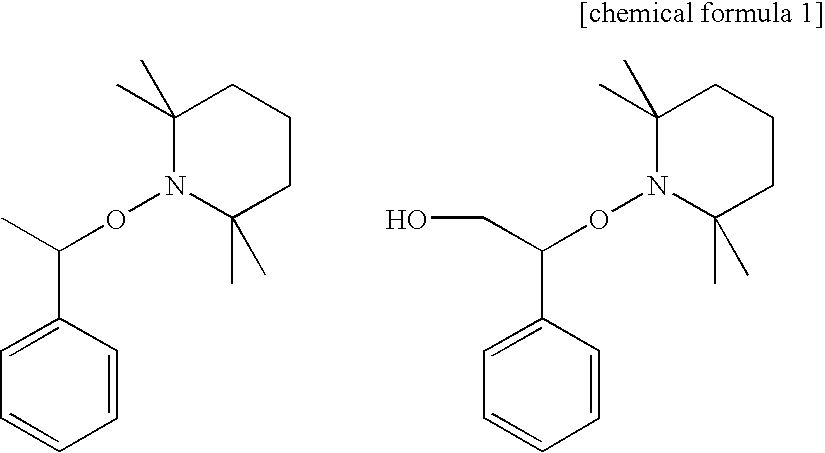Curable composition
- Summary
- Abstract
- Description
- Claims
- Application Information
AI Technical Summary
Benefits of technology
Problems solved by technology
Method used
Image
Examples
synthesis example 1
[0472]Oxygen in a stainless reaction vessel equipped with a stirrer was eliminated, and cuprous bromide and a part of entire butyl acrylate (initial charge monomer) were charged thereto, followed by heating with stirring. Acetonitrile, and diethyl 2,5-dibromoadipate as an initiator were added and mixed. When the temperature of the mixture was adjusted to about 80° C., pentamethyldiethylenetriamine (hereinafter, may be abbreviated as triamine) was added thereto, whereby a polymerization reaction was started. The residual butyl acrylate was sequentially added to allow the polymerization reaction to proceed. During the polymerization, triamine was added appropriately to regulate the polymerization rate. As the polymerization proceeds, the internal temperature is elevated due to the heat of polymerization. Therefore, the polymerization was allowed to proceed while adjusting the internal temperature to be about 80° C. to about 90° C. When the monomer conversion rate (polymerization react...
synthesis example 2
[0480]Oxygen in a stainless reaction vessel equipped with a stirrer was eliminated, and cuprous bromide and a part of entire butyl acrylate (initial charge monomer) were charged thereto, followed by heating with stirring. Acetonitrile, and diethyl 2,5-dibromoadipate as an initiator were added and mixed. When the temperature of the mixture was adjusted to about 80° C., pentamethyldiethylenetriamine (hereinafter, may be abbreviated as triamine) was added thereto, whereby a polymerization reaction was started. The residual butyl acrylate was sequentially added to allow the polymerization reaction to proceed. During the polymerization, triamine was added appropriately to regulate the polymerization rate. As the polymerization proceeds, the internal temperature is elevated due to the heat of polymerization. Therefore, the polymerization was allowed to proceed while adjusting the internal temperature to be about 80° C. to about 90° C.
[0481]Materials used: initiator: 1.76 kg, n-butyl acryl...
example 6
[0490]The curable composition similar to that of Example 4 was prepared, and applied to give a sheet form. Thereafter, aging was allowed without irradiating light, i.e., while shielding the light, at room temperature (23° C.×55% R.H.) for 3 days, and further at 50° C. for 4 days. Consequently, a substantive cured product could be obtained without flowing of the curable composition and stickiness of the surface.
[0491]Accordingly, it is revealed that the curable composition composed of the vinyl polymer (II) having a photo-crosslinkable group and vinyl polymer (I) having a crosslinkable silyl group of the present invention yields a favorable cured product in not only the area where the light reaches by the UV irradiation but also the area where the light does not reach, without flowing of the composition. Therefore, from the results according to the Examples 1 to 6 and Comparative Examples 1 to 2, it is suggested that the curable composition of the present invention achieves hardening...
PUM
| Property | Measurement | Unit |
|---|---|---|
| Fraction | aaaaa | aaaaa |
| Fraction | aaaaa | aaaaa |
| Temperature | aaaaa | aaaaa |
Abstract
Description
Claims
Application Information
 Login to View More
Login to View More - R&D
- Intellectual Property
- Life Sciences
- Materials
- Tech Scout
- Unparalleled Data Quality
- Higher Quality Content
- 60% Fewer Hallucinations
Browse by: Latest US Patents, China's latest patents, Technical Efficacy Thesaurus, Application Domain, Technology Topic, Popular Technical Reports.
© 2025 PatSnap. All rights reserved.Legal|Privacy policy|Modern Slavery Act Transparency Statement|Sitemap|About US| Contact US: help@patsnap.com



